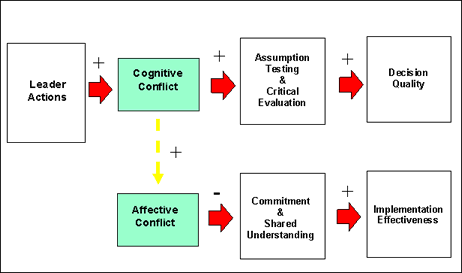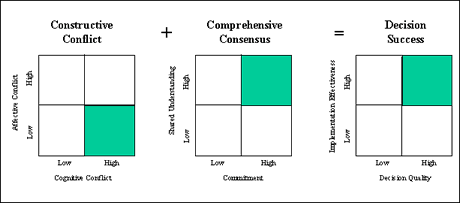|
|
| Home - Industry Article - Oct 05 Issue |
Why Great Leaders Don't Take Yes for an Answer
continued... page 2 |
Unfortunately, when differences of opinion emerge during a discussion, managers may find it difficult to reconcile divergent views. At times, people become wedded to their ideas, and they begin to react quite defensively to criticism. Deliberations become heated, emotions flare, and disagreements become personal. Scholars refer to these types of personality clashes and personal friction as affective conflict. When it surfaces, decision processes often derail. Unfortunately, most leaders find it difficult to foster cognitive conflict without also stimulating interpersonal friction. The inability to disentangle the two forms of conflict has pernicious consequences. Affective conflict diminishes commitment to the choices that are made, and it disrupts the development of shared understanding. It also leads to costly delays in the decision process, meaning that organizations fail to make timely decisions, and they provide competitors with an opportunity to capture advantages in the marketplace. vi Figure 1-2, shown on the following page, depicts how cognitive and affective conflict shape decision-making outcomes.
Figure 1-2: Cognitive and Affective Conflict

Consider the case of a defense electronics firm examining how to restructure a particular line of business. The chief executive wanted to take a hard look at the unit because it had become quite unprofitable. Multiple options emerged, and managers conducted a great deal of quantitative analysis to compare and contrast each possible course of action. A lively set of deliberations ensued. The chief financial officer played a particularly important role. He scrutinized all the proposals very closely, treating each with equal skepticism. One manager remarked that, "He would be able to articulate the black and white logical reasons why things made sense, or why they didn't make sense… He was incredibly objective…like Spock on Star Trek."
Unfortunately, not everyone could remain as objective. Some managers took criticism very personally during the deliberations, and working relationships became strained. Discussions became heated as individuals defended their proposals in which they had invested a great deal of time and energy. Some differences of opinion centered on a substantive issue; in other cases, people disagreed with one another simply because they did not want others to "win" the dispute. As one executive commented, "we could have put the legitimate roadblocks on the table, and separated those from the emotional roadblocks. We would have been much better off. But, we put them all in the same pot and had trouble sorting out which were real and which weren't."
Ultimately, the organization made a decision regarding how to restructure, and looking back, nearly everyone agreed that they had discovered a creative and effective solution to the unit's problems. However, the organization struggled mightily to execute its chosen course of action in a timely and efficient manner. The entire implementation effort suffered from a lack of buy-in among people at various levels of the organization. Management overcame these obstacles, and eventually, the business became much more profitable.
Nevertheless, the failure to develop a high level of consensus during the decision process cost the organization precious time and resources. Figure 1-3, shown below, depicts how conflict and consensus can come together to lead to positive outcomes, rather than poor choices and flawed implementation efforts.
Figure 1-3: The Path to Decision Success

Why Is This So Difficult?
Why is managing conflict and building consensus so challenging? The core contention of this book is that many leaders fail to make and implement decisions successfully for a very fundamental reason - that is, they tend to focus first and foremost on finding the "right" solution when a problem arises, rather than stepping back to determine the "right" process that should be employed to make the decision. They fixate on the question, "What decision should I make?" rather than asking, "How should I go about making the decision?" Answering this "how" question correctly often has a profound impact on a leader's decision-making effectiveness. It enables leaders to create the conditions and mechanisms that will lead to healthy debate and dissent as well as a comprehensive and enduring consensus.
Naturally, leaders also must address the content of critical high-stakes decisions, not simply the processes of deliberation and analysis. They have to take a stand on the issues, and they must make difficult tradeoffs in many cases. Moreover, creating and leading an effective decision-making process does not guarantee a successful choice and smooth implementation. However, developing and managing a high-quality decision-making process does greatly enhance the probability of successful choices and results.vii
Throughout the book, I will argue that leaders should stay attuned constantly to the social, emotional, and political processes of decision. However, they need to do more than this. They must not simply react passively to the personality clashes and backroom maneuvering that emerges during a decision-making process. Instead, they should actively shape and influence the conditions under which people will interact and deliberate. They must make choices about the type of process that they wish to employ and the roles that they want various people to play. In short, leaders must "decide how to decide" as they confront complex and ambiguous situations, rather than fixating solely on the intellectual challenge of finding the optimal solution to the organization's perplexing problems. With this broad theme in mind, let's begin to tackle the marvelous challenge of discovering how leaders can cultivate "diversity in counsel, unity in command."
References:
- J. Byrne, L. Lavelle, N. Byrnes, M. Vickers, A. Borrus. "How to fix corporate governance," Business Week, (May 6, 2002), p. 68.
- Bill Wooldridge and Steven Floyd have defined and operationalized the construct of consensus as the multiplicative function of commitment and shared understanding. Their definition, survey instruments, and measurement methodology have now been used by a number of other scholars. See B. Wooldridge and S. Floyd. (1990). "The strategy process, middle management involvement, and organizational performance," Strategic Management Journal. 11: 231-241. To see how I have measured consensus following a similar methodological approach, see M. Roberto. (2004). "Strategic decision-making processes: Moving beyond the efficiency-consensus tradeoff." Group and Organization Management. 29(6): 625-658.
- A. Amason. (1996). "Distinguishing the effects of functional and dysfunctional conflict on strategic decision making," Academy of Management Journal. 39(1): p. 125.
- For more on what can happen when organizations achieve understanding without commitment, or vice versa, see S. Floyd and B. Wooldridge. (1996). The strategic middle manager: How to create and sustain competitive advantage. San Francisco: Jossey-Bass.
- A. Grove. (1996). Only the paranoid survive: How to exploit the crisis points that challenge every company. New York: Currency-Doubleday. p. 116.
- See Amason (1996) for a detailed discussion of the relationship between cognitive and affective conflict, as well as the effect that these two forms of conflict have on outcomes such as commitment, understanding, and decision quality.
- A great deal of empirical research has shown that certain process attributes tend to enhance decision-making outcomes, i.e. a higher quality process leads to higher quality choices. For instance, see I. Janis. (1989). Crucial Decisions. New York: Free Press; J. Dean and M. Sharfman, (1996). "Does decision process matter?" Academy of Management Journal. 39: 368-396. For a review of studies in this area, see N. Rajagopalan, A. Rasheed, and D. Datta. (1993). "Strategic decision processes: Critical review and future directions." Journal of Management. 19: 349-364.
Michael Roberto is a faculty member in the General Management unit at Harvard Business School. He teaches courses on general management, managerial decision-making, and business strategy. Michael" s research focuses on strategic decision-making processes and senior management teams. His new book, Why Great Leaders Don't Take Yes For An Answer: Managing for Conflict and Consensus, was released in June 2005 by Wharton School Publishing. For article feedback, he can be reached at: mroberto@hbs.edu
 

|
|


|

